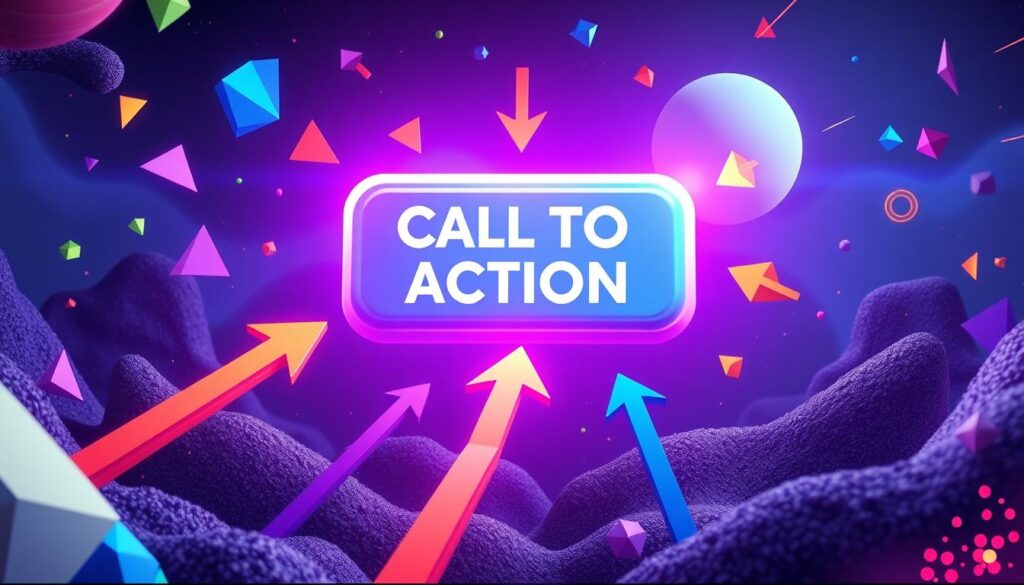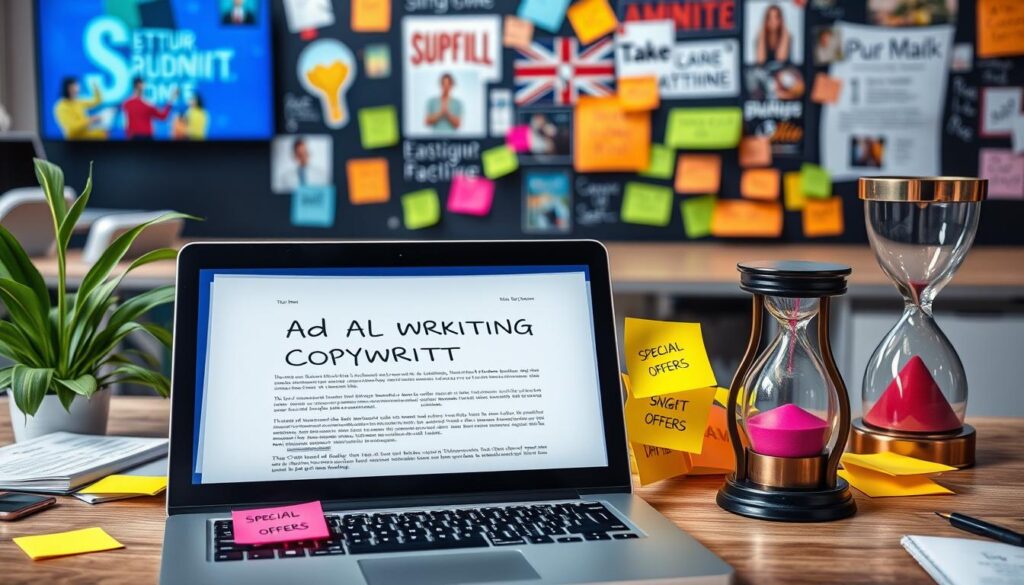When someone clicks on our digital ads, it’s exciting. It shows our message has sparked interest. But in the world of digital marketing, getting that click takes more than luck. It needs ad copywriting tips that are sharp and focused on enhancing click-through rates through copywriting.
Think of ads as a busy street market. Your product needs to stand out among many. To get someone to visit your website, you must show them why they should. This is the art of copy – making people want to click to see more.
As we learn about writing ad copy that works, remember it’s not just about getting eyes. It’s about starting meaningful interactions and getting results.
Let’s explore how to make ad copy that stands out in the digital world. We’ll turn glances into clicks and clicks into lasting connections.
Learn more about click-through ratesand why they’re key for your digital campaigns.
Key Takeaways
- Converting viewers into clickers requires ad copy that communicates value and relevance.
- Ad copywriting is an art that fuses creativity with marketing savvy to enhance user engagement.
- CTRs can be improved significantly through careful study and application of proven copywriting tips.
- Understanding your audience is essential to crafting messages that resonate and drive action.
- Key metrics and analytics can guide better ad copy practices and optimize marketing performance.
The Art and Science of Ad Copywriting: An Introduction
In digital marketing, knowing how to write ads is key. It’s not just about filling space. It’s about making messages that grab attention and lead to action. Using the AIDA model helps guide people from interest to action.
To make ads work better, focus on key elements. Keep the message short and engaging. Use tactics like FOMO to create a sense of urgency. Also, show credibility with data and testimonials to boost click-through rates.
Artificial intelligence (AI) is changing ad copywriting. It has helped companies like Chase Bank and travel agencies see big improvements. AI helps with everything from monitoring performance to making ads more personal.
Captivating ad copy is an art perfected through the continuous interplay of creativity and strategic execution. Storytelling, tailored CTAs, and sensory language enveloped in optimized, SEO-forward content craft not just adverts but customer journeys that convert browsers into buyers.
For small businesses, writing ads can be tough. They often have to learn on their own. AI helps level the playing field by making advanced marketing tools available to everyone.
Understanding ad copywriting is crucial for business growth. Whether using AI or manual methods, the goal is to tell a story that impacts the audience.
As we delve deeper into ad copywriting, it’s clear that learning and innovation are essential. These practices not only enhance click-through rates but also improve the entire customer journey.
Understanding Your Target Audience for Better Engagement
To really connect with your audience, you need to know what they like, what they’ve been through, and how they act. This knowledge is key to writing effective ad copy to boost click-through rates and create compelling ad content. Let’s look at how we can build a strong bond with our audience through targeted strategies.
Creating Audience Personas Based on Data
We make detailed audience personas by studying their behaviors and collecting lots of data. These personas help us picture our perfect customer. This way, we can craft messages that really speak to their needs and wants.
For example, McKinsey and Company found that companies that personalize their approach make 40% more money than those that don’t. This shows how important it is to know things like age, job, and interests when creating these personas.
Identifying Customer Pain Points
It’s vital to know what troubles or challenges your audience faces. Are they looking for something easy, cheaper, or of higher quality? Or do they need more info before deciding? Our goal is to tackle these issues head-on with our ad copy, offering clear solutions right away.
Stats like “71% of consumers expect personalized interactions” show how crucial it is to tailor our messages. This approach boosts engagement and conversions.
Engagement Patterns and Behavior Analysis
Watching how users interact with different content types helps us improve our strategies. For instance, 80% of people will read headlines, but only 20% will read the rest. This shows how critical it is to make headlines that grab attention and encourage more reading.
By analyzing these patterns, we can make our ads more engaging. This leads to better results for your marketing efforts.
Using these strategies in your marketing can really help you connect with your audience. By deeply understanding your audience, creating empathetic personas, and targeting their pain points, your ads become more than just promotions. They become solutions that meet your audience’s needs and expectations. This approach is key to getting your audience to take action, which boosts click-through rates and drives conversions.
Writing Effective Ad Copy to Boost Click-Through Rates
In today’s digital world, businesses must grab attention quickly. They need to use ad copywriting tips to connect with potential customers. The goal is to create ad copy that speaks to your audience and gets them to take action, helping to improve ctr with ad copy.
It’s important to clearly state the benefits of your product. Instead of just listing features, talk about how it solves problems or improves lives. Using emotional triggers can make your ad more compelling, as it taps into feelings that drive buying decisions.
Being specific in your ad copy boosts credibility and grabs the audience’s interest. Use data to find out what matters most to your audience. For example, highlighting resort amenities in a promotional campaign can improve ctr with ad copy by showing important details quickly.
Creating a sense of urgency is key. Phrases like “limited offer” or “sale ends soon” can prompt people to click faster. But, always be truthful to keep your audience’s trust.
Writing in a friendly, conversational tone can build a stronger connection with your audience. It makes the ad feel more personal and can increase engagement and clicks.
| Tactic | Benefit | Impact on CTR |
|---|---|---|
| Benefit-focused Copy | Directly addresses customer needs | Increases relevancy and engagement |
| Use of Emotional Triggers | Connects on an emotional level | Enhances click motivation |
| Creating Urgency | Encourages immediate response | Boosts immediate clicks |
| Conversational Tone | Makes copy relatable and personal | Enhances user connection |
In conclusion, using these strategies can make your ad copy more effective. It helps your campaigns get more clicks. Our goal is to create messages that grab attention, touch hearts, and inspire action. By following these ad copywriting tips, we can make our ads more engaging and successful, leading to better conversions.
The Power of a Clear, Compelling Call-to-Action
In the fast-paced world of digital ads, the call to action (CTA) is key. It’s what turns users into doers. To optimize ad copy and improve our ad writing strategies, we must grasp the power of a good CTA. A well-written CTA uses words to push users toward action, boosting success rates.

Utilizing Action Verbs
Using strong verbs is a top way to make a CTA effective. Verbs like ‘Buy’, ‘Register’, ‘Subscribe’, or ‘Download’ urge users to act. They make the action clear and beneficial.
Creating Urgency in Your CTA
Urgency is a big motivator. Adding words like ‘Limited Offer’, ‘Hurry’, or ‘Now’ can prompt action. This approach not only makes ads better but also taps into human psychology.
Highlighting Benefits for Conversion
Your CTA should clearly show what users gain. Saying ‘Start my free trial’ instead of ‘Sign up for a trial’ adds value. Also, placing the CTA after engaging content can boost action.
Integrating CTAs well across content types can greatly improve campaign success. For more on creating effective CTAs, check out effective call-to-action examples.
| Component | Role in Conversion | Impact Example |
|---|---|---|
| Action Verbs | Spur immediate response | Increased CTR by 75% using ‘Buy now!’ |
| Urgency | Adds time sensitivity | ‘Offer ends soon’ boosted sales by 50% |
| Benefits Highlight | Clarifies the offer’s value | ‘Join and start saving today’ resulted in 90% more sign-ups |
By using these elements well, we can make our digital marketing more effective. Each part of your ad, especially the CTA, should work together to turn interest into action. This aligns with your marketing goals and shows real results.
Evoke Sensory Experience to Deepen Impact
When we aim to create compelling ad content, using sensory words is key. It turns simple messages into immersive experiences. Ads that tap into our senses can make us feel and connect on a deeper level. This can really increase click-through rate and build a stronger bond with the audience.
Think about the smell of freshly brewed coffee or the feel of a new book. These examples use sensory language to create vivid, relatable moments. To learn more about crafting effective ads, it’s important to add sensory details. These should appeal to our senses like sight, sound, touch, smell, and taste.
By using a strategic approach in our ad copy, we aim to offer real experiences. These experiences help potential customers emotionally connect with what we’re offering. This way, we can create compelling ad content that truly resonates.
| Strategy | Benefit | Example |
|---|---|---|
| Use of Visuals | Increases engagement | Vivid imagery in ads |
| Textural Descriptions | Enhances tactile involvement | “Silky smooth fabric” |
| Aromatic Words | Evokes scent memories | “Hint of lavender” |
| Auditory Language | Stimulates sound association | “Crisp, crackling fire” |
| Gustatory Terms | Invokes taste | “Sweet, succulent strawberries” |
This multi-sensory approach makes ads more impactful and memorable. It helps increase click-through rates by making ads more engaging. By using sensory language well, we turn ordinary ad content into stories that deeply connect with the audience.
Optimizing Ad Copy for Different Digital Platforms
Digital advertising is always changing. We need to adjust our strategies for each platform. Good ad copywriting tips can make our ads more engaging. This way, our content gets noticed and interacts with our audience.
Platform-Specific Copy Adaptations
Adapting our message for each platform is crucial. What works on Facebook might not work on Twitter. We use Google Analytics to understand our audience better. This helps us target our messages more accurately.
Conducting Platform-Centric A/B Testing
A/B testing is key to finding the best ad copy for each platform. We test different parts of our ads to see what works best. Google Ads helps us do this, giving us insights to improve our ads.
Staying Updated with Platform Trends
To stay ahead in digital advertising, we must keep up with platform trends. Google Trends helps us find out what our audience likes. This keeps our ads relevant and effective.
| Feature | Benefit | Tools Used |
|---|---|---|
| Keyword Optimization | Improves ad visibility and effectiveness | Google Keyword Planner |
| A/B Testing | Fine-tunes messaging for higher CTR | Google Ads |
| Trend Analysis | Keeps ad content relevant and timely | Google Trends |
In conclusion, to optimize ad content across platforms, we need to understand each platform’s unique needs. By using our ad copywriting tips, we make our ads not just seen but also engaging. This ensures our digital advertising efforts are effective.
Achieving Authenticity Through Conversational Tone
In today’s digital world, adding a personal touch to ads can really engage people. Using ad writing strategies with a friendly tone makes content more relatable. This builds a strong bond between the brand and the consumer. By writing effective ad copy to boost click-through rates, companies see better responses and more sales.
Your ad copy should feel like a real conversation. Use simple words, contractions, and a welcoming tone. It’s like talking to someone you know well. This creates a real connection, not just a sale.
| Technique | Impact |
|---|---|
| Conversational Tone | Heightens engagement by creating personal connections |
| Simple Language | Improves clarity and retention of the message |
| Direct Questions | Increases interaction, making ads more dynamic |
| Relatability | Enhances trust and credibility, encouraging positive reactions to CTAs |
Knowing what your audience wants is key. Use direct questions or detailed profiles to improve your ad writing strategies. For example, personalized CTAs can lead to much better results than generic ones.
By mixing the friendly feel of everyday talk with the careful planning of ads, you create a voice that really speaks to people. This leads to more clicks and sales.
In conclusion, keeping up with trends and what others are doing is important. Using a conversational tone is more than just writing differently. It’s about changing how people see and interact with your brand.
Dissecting the Anatomy of High-Converting Headlines
To make your ads better and get more clicks, start with the headline. It’s key because it’s the first thing people see. We’ll look at what makes a headline truly stand out.
Importance of Clarity and Relevance
Clear headlines are easy to get and make people want to learn more. They should match what your audience is looking for. This makes your ad more relevant and likely to get clicked.
Employing Emotional Triggers in Headlines
Using emotional triggers in headlines can really grab attention. It makes people curious, excited, or feel a sense of urgency. This encourages them to click and see what’s next.
Testing Headlines for Optimal Engagement
Testing different headlines is key to finding what works best. By trying out different versions, we can improve our ads. This helps us get more people to click on them.

| Ad Element | Character Limits | Notes |
|---|---|---|
| Headline | Up to 30 characters each for three headlines | Headline 3 may not always appear |
| Description | Up to 90 characters each for two descriptions | Description 2 may not always appear |
| Display URL | Less than 35 characters | Can include vanity paths to enhance relevancy |
| Sitelink Extensions | Up to 25 characters each | Desktop: Max of six, min of two required; Mobile: Max of eight, min of one required |
| Callouts | Up to ten callouts allowed | Can be added at various levels without additional costs |
Employing Storytelling Elements in Ad Copy
Using storytelling in ad copy helps us connect deeply with our audience and improve ctr with ad copy. It’s all about grabbing attention and touching emotions in key moments.
Storytelling isn’t just telling a story. It’s about creating relatable moments that mirror our audience’s lives or dreams. This way, we make the most of the short time our ads have on platforms like Facebook. Quick, impactful storytelling can make a big difference in just a few seconds.
Narrative-Driven Ad Structures
We use the AIDA principle—Attention, Interest, Desire, Action—to craft our ads. It starts with a catchy headline to grab attention. Then, we build interest and desire with a compelling story. Finally, we end with a strong call-to-action to prompt action.
Capitalizing on Key Moments
Highlighting key emotional or decisive moments in our stories can greatly improve ctr with ad copy. By focusing on these moments, we create messages that truly resonate. This is especially true on platforms like Instagram, where visuals and minimal text are key.
We also use A/B testing to refine our approach. This helps us see what works best in real-time. It allows us to optimize PPC campaigns for better engagement and conversion rates.
| Platform | Engagement Time | Key Focus |
|---|---|---|
| 2.0 seconds | Instant hooks, emotional peak moments | |
| 1.7 seconds | Visual storytelling, concise text | |
| Varies | High-impact visuals, punchy copy | |
| Google Search | N/A | Benefits-driven, emotional resonance |
Through strategic storytelling, we bring our ads to life. We create stories that stay with our audience long after they’ve scrolled by. Our goal is to leave a lasting impression and drive meaningful engagement.
Utilizing Social Proof and Testimonials
In the digital world, using social proof can really boost your ad’s success. It builds trust and encourages people to take action. By sharing testimonials and reviews, you show that your product is trusted by others. This can make potential customers more likely to buy.
Here’s a table that shows how different types of social proof can help your marketing:
| Type of Social Proof | Description | Impact on Customer Decision |
|---|---|---|
| Customer Testimonials | Real stories from customers that outline the product’s effectiveness in solving specific problems. | Increases credibility; potential customers see proof of satisfaction. |
| Expert Opinions | Endorsements from credible professionals in the industry. | Adds authority to the product, enhancing trust. |
| Celebrity Endorsements | Product endorsements from popular figures tailored to match the target audience’s preferences. | Can lead to quick boosts in product interest and trust due to the celebrity’s influence. |
| Social Media Influencers | In-depth product discussions and endorsements by influencers in a less formal, personal style. | Creates buzz and relatability, particularly among the influencer’s followers. |
| User-Generated Reviews | Feedback and ratings posted by users on platforms like Amazon and Google Reviews. | Offers unfiltered insight into the product’s performance, heavily influencing purchase decisions. |
Using testimonials in ads can make them more personal and relatable. This approach is key to getting new customers to click and explore what you offer.
We always get permission to use personal details in testimonials. This makes them more believable and appealing. We also add real customer feedback and data to strengthen the social proof.
“Empirical data show that nearly 70% of online consumers look at a product review before making a purchase.”
By using social proof in your ad copy, you create content that feels real and authentic. This approach not only boosts click-through rates but also turns potential customers into real buyers. It makes your brand more trustworthy and reduces the risk in their minds.

Structuring Ad Copy for Skimming Readers
In today’s fast world, people spend only seconds on a page. This means our ad copy must grab attention quickly. We focus on web design and content to keep ads effective.
Writing for the F-Shaped Reading Pattern
Most online readers follow an F-shaped pattern. They start with the top line, then move down and scan the left side. By placing key info at these points, we can grab attention better. This can increase engagement and clicks.
Keeping It Short and Impactful
Facebook users spend just 1.7 seconds on mobile content. So, our ad copy must be short and to the point. Every word counts, delivering value and intent quickly. A clear value proposition and call to action can make all the difference.
| Element | Importance |
|---|---|
| Value Proposition | Central to stopping the scroll |
| Call To Action (CTA) | Directs user engagement |
| Headline | Captures attention, drives curiosity |
| Visual Elements | Enhances text, provides context |
| Brand Differentiation | Establishes uniqueness, competes effectively |
Using these strategies can improve engagement and ROI. Studies by Wordstream and data on CPG advertising show this.
Our goal in ad copy is to be clear and persuasive. Looking at brands like Liquid Death and Blume can teach us. They show how to create ads that people act on, not just see.
Incorporating Special Offers and Urgency
To optimize ad copy for maximum impact, adding special offers with a sense of urgency is key. This approach can greatly increase engagement and conversions. It’s crucial for any marketing team to understand how to create compelling and urgent ad content.
When writing ad headlines, it’s important to keep them clear, relevant, and include primary keywords. This attracts the right audience and fits well within platforms like Google Ads. It makes communication more efficient.
| Element | Guideline | Effectiveness |
|---|---|---|
| Headlines | Up to 30 characters | High CTR when clear and keyword-focused |
| URLs | Display URLs that align with the ad’s message | Increases user trust and CTR |
| CTAs | Create urgency or showcase value | Converts clicks into actions effectively |
| Grammar | Use tools like Grammar Checker | Ensures engagement through readability |
| Power Words | Include words like “free” | Significantly boosts CTR |
For businesses targeting B2C audiences, focusing on personal benefits and using urgency-driven phrases like “Limited Time Offer” can be very effective. On the other hand, B2B ad copy should have a more formal tone. It should emphasize ROI and efficiency to engage professional clients.
Using powerful CTA statements, like “Explore Our Exclusive Sale Now!” guides users and creates a sense of urgency. This encourages them to take action right away. Adding visually striking elements like color contrasts makes the ad stand out and grabs attention quickly.
Following advertising standards, like avoiding deceptive content and ensuring URL relevancy, keeps your brand’s integrity and trust with your audience. For more details on creating urgency in search ads without being pushy, visit our insights page.
By effectively using these strategies, we can greatly optimize ad copy and create compelling promotions. These not only attract but also convert, maximizing the potential of ad writing strategies to drive business growth.

Leveraging the Persuasiveness of Free Value
Creating compelling ad content is key to boosting click-through rates. Offering ‘free’ value taps into our desire for something without cost. This approach significantly increases user engagement and conversion rates.
Understanding 'Free' as a Psychological Trigger
When we say something is free, it creates a sense of urgency and desire. It’s not just about saving money but also about appealing to our emotions. This makes a strong connection with the audience.
By highlighting no risk and high reward, we make it easier for people to act. They are more likely to take action they might have hesitated over.
Integrating Free Offers Into Your CTA
To boost click-through rates, add free offers to your Call-to-Action (CTA). This grabs attention and offers a clear reason to click. It’s crucial for turning passive readers into active participants.
| Industry | Average CTR (Google Search Ads) | Average CTR (Facebook Ads) |
|---|---|---|
| Dating and Personals | 6% | 0.7% |
| Legal Services | 1.35% | 0.6% |
| Retail and E-commerce | 2-3% | 0.8% |
| Email Marketing | 2.5% (personalized campaigns) | N/A |
Adding free offers to ads, like discounts or trial memberships, grabs interest. It drives conversions. The data shows that using emotional and value-centric triggers is effective. It attracts views and turns them into actions.
Improving CTR with Precise Ad Copy Testing
In the world of digital marketing, A/B testing is a key way to boost your ad’s performance. By comparing different ad versions, you can increase click-through rates and improve your marketing strategy.
Implementing A/B Testing Methodologies
A/B testing is crucial for making ads better. For example, 63% of companies use it to find out which messages work best. Testing different headlines, calls to action, and visuals helps tailor ads to better engage audiences. In fact, changing ad headlines can raise CTRs by up to 21%, showing the power of good wording.
Measuring Impact with Detailed Analytics
It’s not just about starting tests, but also understanding the results. A 1% increase in CTR can lead to more sales, showing how effective ad copy can be. A/B testing can also boost conversion rates by 25% and increase average order value by 15%. Detailed analytics help us see which changes work best, guiding future ad improvements.
Also, making ads more relevant can improve user experience, with 80% of companies using A/B testing for this. Different industries have varying CTRs on Facebook, from 0.90% on average to higher rates in retail and apparel. This highlights the need for tailored ad strategies to boost CTR.
Keeping an eye on analytics and adjusting based on feedback is key to a strong ad testing strategy. This ongoing cycle of testing, measuring, and refining helps marketers create ads that not only get clicked but also lead to conversions.
Combining creative A/B testing with detailed analytics ensures every ad tweak aims for higher click-through rates and conversions. This approach drives real results in a competitive digital space.

| Aspect | Impact on CTR | Impact on Conversion Rate |
|---|---|---|
| Ad Headlines | Up to 21% increase | Varies, needs to be measured alongside conversions |
| A/B Testing | Up to 20% increase | Up to 25% increase |
| Average Order Value | May contribute to an increase | Up to 15% increase |
Adapting Ad Copy Based on Consumer Feedback
To improve ctr with ad copy, we need to be flexible. Brands must listen and use feedback to make their ads better. This keeps their messages fresh and engaging for their audience.
Using feedback well can make ads more effective. It helps advertisers know what their audience likes. This turns good ads into great ones that keep people interested, leading to more sales and better returns.
Using what we learn from consumers makes ads more personal. This is important for delivering the right message at the right time. Testing different versions of ads based on feedback is a key part of making them better.
| Feature | Benefits | Consumer Feedback Impact |
|---|---|---|
| Dynamic Keyword Insertion (DKI) | Improves ad relevance and performance | Can lead to grammatical inconsistencies if not properly managed |
| Negative Keywords | Improves ad spend efficiency | Requires continual updates based on consumer search trends |
| Urgency in CTAs | Increases likelihood of immediate conversions | Feedback can refine the tone and urgency level to match consumer preference |
| Callout Extensions | Highlights product advantages | Feedback helps identify which features to highlight for maximum impact |
The world of ads is always changing. Better ad copy practices help us stay on top. By listening to and acting on what our customers say, we make our ads better. This builds stronger connections with our audience through messages that really speak to them.
Conclusion
We’ve looked into how to make ads better by using various techniques. It’s a mix of science and creativity, where every word matters. Google AdSense and social networks like Meta and LinkedIn give us tips on how to place ads for the best results.
Ad copywriting is all about a good headline, a clear description, and a strong call to action. By using different types of ads, we can connect with our audience on a deeper level. Whether writing by hand or on a computer, our goal is to engage people in a meaningful way.
As marketers and writers, we need to keep improving and listening to what people say. We should make sure our ads are not only eye-catching but also effective. Every click is important, as it shows someone is interested. So, let’s keep making ads that grab attention and lead to valuable actions, always keeping in mind that each click is a person, not just a number.
FAQ
How can I write ad copy that increases my click-through rate?
To boost your CTR, start by understanding your audience. Create a compelling call-to-action (CTA) with action verbs and urgency. Use storytelling and make sure your headlines are clear and relevant.
Also, add social proof and special offers. Keep testing and improving your ad copy based on feedback and A/B testing.
What are some effective ad copywriting tips?
First, know your audience’s needs. Use sensory language to create immersive experiences. Craft striking headlines and keep your tone conversational.
Use psychological triggers like ‘free’. Make sure to include social proof and testimonials to build trust.
Why is a clear CTA important in ad copy?
A clear CTA guides the user on what to do next. Use direct language and create a sense of urgency. Highlight the benefits to increase engagement and CTR.
How do I tailor my ad copy for different digital platforms?
Optimize your ad copy for each platform by following their guidelines. Adapt your messaging to fit the audience behavior of each platform. Stay updated on trends and test different versions on each platform.
How can I craft compelling headlines?
For compelling headlines, focus on clarity and relevance. Evoke emotional reactions. Test different headlines to see which gets more attention and engagement.
What role does storytelling play in ad copy?
Storytelling increases engagement by creating an emotional connection. Use narrative structures and compelling moments. This makes your ad memorable and persuasive, encouraging clicks.
How can I make my ad copy more compelling for skimming readers?
To grab skimmers’ attention, write concise ad copy. Use formatting to highlight key information. Write in an F-shaped pattern and emphasize clarity to make your ad more skimmable and clickable.
How does incorporating free value in ad copy enhance CTR?
“Free” is a powerful motivator because it offers value without risk. Include free value propositions authentically in your CTA. This can trigger an emotional response and increase clicks, improving your CTR.
Why is A/B testing important for improving ad copy?
A/B testing helps you compare different ad versions to find the best one. Use analytics from testing to refine your ad copy. This ensures it resonates with your audience and boosts CTR.
How do I adapt my ad copy based on consumer feedback?
Use customer feedback to refine your messaging. Ensure it continues to resonate with your target audience. By listening and responding to consumer insights, you can adjust your ad copy to meet their needs and preferences, improving CTR.

